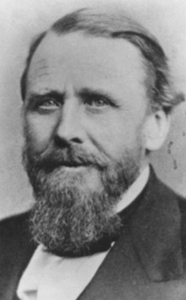
Photo info …
Credit: Colorado State Archives, Public domain, via Wikimedia CommonsView Source
(Mar. 9, 1814-July 3, 1897). Evans was born in Warren County, Ohio, to Quaker parents. He attended the Hicksite school in Richmond, Indiana, and received his M.D. degree from Cincinnati College in 1838. After marrying Hannah Canby, the couple moved to Attica, Indiana. Here, Evans first became concerned with the care and treatment of the mentally ill.
During the early 1840s, Evans urged the General Assembly to construct a hospital for the insane, a project that the legislature authorized during its 1845-1846 session. By visiting eastern mental hospitals at his own expense, Evans became knowledgeable about their special architectural requirements (massive firewalls, for example). In 1846, he and his family moved to Indianapolis, and for the next two years, he supervised the construction of the Indiana Hospital for the Insane (see ).
The Evans family moved to Chicago in 1848, where Evans became involved with building Chicago’s first hospital and establishing the city’s medical society, public school system, and parks. He was also actively involved in the founding of Northwestern University and the town of Evanston, Illinois, as well as with the promotion and construction of railroads.
In 1862, President Abraham Lincoln appointed Evans governor of Colorado Territory. Following the close of the Civil War, he once again began building railroads, this time to connect Denver to the transcontinental railroad via the Denver Pacific. Mount Evans, southwest of Denver, is named in his honor.
Two years after his appointment as Colorado Territory governor, Evans was forced to resign due to his part in the Sand Creek Massacre. As superintendent of Indian Affairs in the Colorado Territory, Evans failed to represent the best interests of Colorado’s Native Americans. He assigned the tribes to reservations, issued a proclamation for citizens to kill “hostile Indians”–those found outside their specified reservations–and failed to create policy to ensure peace despite meeting with Cheyenne and Arapaho leaders. Though he was not directly involved in the Sand Creek Massacre, it was his negligence in protecting the native community which led to the slaughter of over 100 peaceful Cheyenne and Arapaho women, children, and elderly in 1864.
In 1865 two U.S. Congressional committees and one military committee investigated the massacre. The group placed part of the guilt for the massacre on the U.S. government and accused Evans of a coverup. He was forced to step down as the territorial governor that year.
In 1895 the prominent mountain that overlooks current-day Denver, Colorado was officially named Mount Evans after John Evans. On September 15, 2023, the U.S. Board on Geographic Names officially renamed Mount Evans to Mount Blue Sky during the Council of Geographic Names Authorities conference. The Arapaho people are known as the “Blue Sky people” by some other tribes and the Southern Cheyenne have an annual ceremony known as Blue Sky. The peak is located in Clear Creek County, Colorado at an elevation of approximately 14,258 feet.

Help improve this entry
Contribute information, offer corrections, suggest images.
You can also recommend new entries related to this topic.

